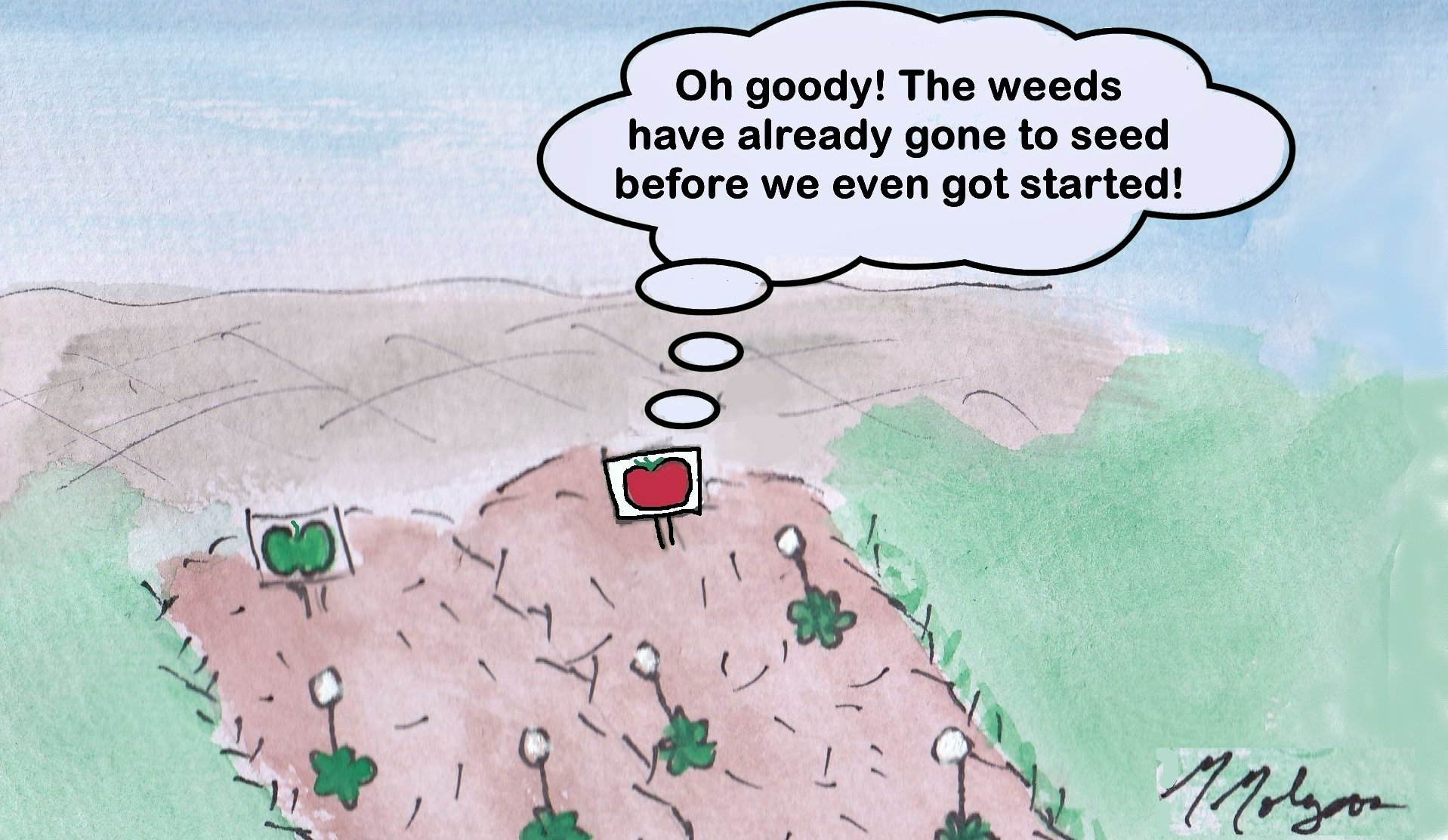Pioneer species are the first plants to establish in an area after a disturbance. The disturbance may be a fire, a flood, a tree uprooting the soil as it falls, a tractor tilling the ground, or a gardener pulling weeds out by the roots. These things expose the seed bank already in the earth to sunlight they need to germinate. Part one of this series gave you some diagnostic characteristics in helping you identify the pioneer species of wildflowers in your gardens that you want to perpetuate beyond their natural life cycle. In Part 2, we will examine how to avoid the seeds in the seed bank that most folks do not want in their garden – weeds!
Most weeds are fast-growing annuals; you combat them by crowding them out (low tolerance for crowding is a trait of pioneer species) by having vigorous, healthy plants in your garden. This is where green mulch comes in. Look at plant spacing in your garden. If you leave space between plants for future growth, something will grow there voluntarily, most likely something you don’t want. Now I know most of us know to mulch our gardens, but we have used brown mulch in the past and we still had to weed. Then there was the annual expense of refreshing the mulch. With green mulch, you plant it once, get more flowers, fewer weeds, and vertical layering.
Green mulch is any low-growing plant that can spread, either by self-seeding, rhizomes, or stolons, filling the spaces between the primary plants of the garden; green mulch functions as the “matrix” in the landscape plan. As the primary plants grow more prominent, the matrix plants are shaded out, but their temporary presents provide many valuable services to the garden.
Green mulch covers the ground preventing light from getting to the soil, thus preventing weed seed germination. It also helps cool the earth and reduce evaporation, conserving moisture and helping break up the ground with its roots thereby increasing water infiltration while also helping to prevent erosion. Some natives that work well you may think of as weeds. This is the age of natives; let go of old ideas.
You will find native groundcovers on the internet or at native nurseries. Plants you can buy either bare root or in plugs are: Green and Gold (Chrysogonum virginianum), Moss Phlox (Phlox subulata), Creeping Phlox (Phlox stoloniferous), an early nectar plant, and Wild Strawberries (Fragaria virginiana) a butterfly host plant. In two years, two bare-root packs of wild strawberries solidly covered an eighty-square-foot slope for me. If you are fortunate enough to have natives volunteer in your yard, then consider yourself lucky! These might be common blue violet (Viola sororia), a butterfly host; Carolina Ponyfoot (Dichondra carolina), a cultivar is sold in hanging baskets; Dwarf Cinquefoil (Potentilla canadensis) a butterfly host plant; and Creeping Lespedeza (Lespedeza repens), a legume that nitrifies the soil.
Not sold on the idea, but willing to give it a try? During early spring find a spot under shrubs that don’t have a ground-hugging layer of plants or a bed that has yet to fill in and begin there. As your plants proliferate, you’ll be able to take cuttings to move to other areas.
Now I’m sure what caught your eye in the description of the disturbance is “tilling the ground, or a gardener pulling weeds.” You probably do one or both, so what are your options? If you grow veggies, you have probably heard of no-till gardening. I’ve never tried it; I don’t have a place for veggies except for my front lawn, hum? There are several references on the internet. Rather than take the advice of a random article, I recommend the Extension office at the University of New Hampshire. Yes, they are in the northeast, but the information still applies. Low and No-Till Gardening | Extension (unh.edu) https://extension.unh.edu/blog/2020/10/low-no-till-gardening
Don’t grow veggies? You have flower beds, and it is very satisfying pulling weeds out by their roots. You feel like you’ve at least eliminated that one. Well, you did, but you also brought up more weed seeds in the process. The recommended weeding process is to cut the weed at the soil line removing the photosynthetic part, which starves the roots. The root rots, providing organic nutrients for the soil.
Suppose the weed is something like a dandelion that may resprout from the root, cut it again before it disseminates seed. Dandelions have deep taproots; trying to pull out the whole root is sure to disturb the soil, and it may resprout from any part you leave behind. It is better to starve it by continuously removing the leaves, depleting its energy, and not allowing it to reproduce. The hardest part of this is the self-restraint it takes NOT to PULL!
Read more at Gardening Know How: What Is Living Mulch: How to Use Living Mulch As A Ground Cover https://www.gardeningknowhow.com/edible/grains/cover-crops/living-mulch-ground-cover.htm
The UGA Extension service has an excellent publication on weeds, but it is currently being revised: Weeds of Southern Turfgrasses, Special Bulletin 31. I don’t know when the revised edition will come out. Meanwhile, if you need help identifying your weeds, you can look to Virginia Tech’s Start – Weed Identification (vt.edu). https://weedid.cals.vt.edu

